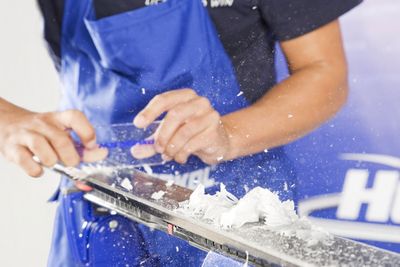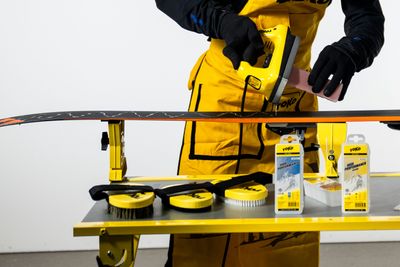Contents
How to wax your own skis!
If you want to enjoy your skis for a long time, you should care for them regularly. An important point here is waxing the skis. Only when the base is in good condition can the skis perform well on the slopes. Many people have their skis serviced by a professional, but you can also wax your skis yourself. It's easier than you might think. We'll explain the options available to you and how they work. Let's go!
Hot or cold wax: What's the difference?
There are basically two options for ski waxing: Cold wax and hot wax. The first difference is obvious. Cold wax is applied cold, hot wax has to be heated. The treatment with hot wax is therefore associated with more effort and requires the necessary equipment, while the application of cold wax is quick and uncomplicated.

However, the quality of the result also differs in the end. Cold wax is less abrasion resistant and therefore needs to be renewed more often. Hot wax, on the other hand, can penetrate deeper into the pores of the surface through heating and thus keeps it smooth for much longer.
Additionally, there are waxes that are specially designed for certain snow conditions. However, an ordinary universal wax is often completely sufficient.
Which method is right for you?
For occasional skiers who usually only spend one or two days at a time on the slopes, the cold wax treatment is probably enough. You don't need any additional equipment and can simply apply the wax before your ski day.
However, if you ski more often and for a longer period of time, it is worth the effort to use hot wax. The wax layer remains smooth for much longer and does not need to be constantly renewed.
Advantages and disadvantages at a glance
| Cold wax | Hot wax |
|
+ quick, uncomplicated application - needs to be renewed much more frequently |
- more complex to use + lasts significantly longer |
Ski waxing with hot wax
Preparation
First, fix your skis with the underside facing upwards and tighten the brakes of the bindings with a rubber band so that they do not interfere with waxing. Use a cloth to remove the coarse dirt from the base.
Waxing

Once the iron is ready for use, heat the wax on it and let it drip down the entire length of the ski. Then iron the wax into the base. When doing this, make sure that you don't stay in one place for too long - just like when ironing shirts - but keep moving. When the wax is evenly distributed over the entire ski, let the ski cool down for about 15 to 30 minutes.
Finish
Once the ski has cooled down completely, the excess wax is removed with a plastic scraper. To do this, pull the blade backwards from the tip of the ski several times with pressure. These blades often have small recesses at the corner. These are there to remove the wax residue from the edges. Finally, brush the ski again lightly with a nylon brush - again from front to back - and wipe away the remaining dust with a microfibre cloth. That's it!
Alpine: Hot Waxing
The experts from TOKO show how waxing with hot wax works.
Ski waxing with cold wax
Waxing with cold wax is less time-consuming. But here, too, the first step is to fix the ski and remove dirt with a cloth. Then the cold wax is applied directly to the base. You should make sure that the wax is evenly distributed. Then it is worked in with a polishing felt or cork. Done!
Cold wax is often available as a practical stick with the polishing felt already integrated. Alternatively, there are now liquid waxes or ski wax sprays that are just as easy to apply as the classic cold wax.
Natural ski wax stick
Quick and easy: this is how waxing works with the Natural Skiwax Stick from Holmenkol.When and how often?
Finally, when should you wax your skis?
Of course, you can wax them at the start of the season and hit the slopes with a fresh base. Alternatively, the end of the season is a good time to wax your skis before they go into storage for the summer. On the one hand, the applied wax layer serves as rust protection, and on the other hand, you are ready to go as soon as the first snow falls.
Depending on how often you ski, you may also need to wax during the season. As mentioned above, you will also need to wax more often if you use cold wax. If the base feels rough and the colour looks greyish or dull, it's time for a new waxing treatment.
Of course, you can find everything you need for ski waxing in our shop!
(Photos: TOKO, Holmenkol)

